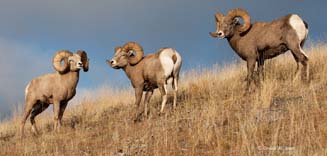Mongolian wild animals
Przewalski horse is simply a last remaining wild horse. In late 19th century a Russian explorer N.M.Przewalski scientifically described this amazing creature and named by his own name. This wild horse can be characterized by short and strong muscular body, reddish brown hair which is short in summer time and turns fluffy in the winter. Przewalski horse’s average weight is about 200 to 320kg. These horses eat grass and vegetation on Mongolian steppe. Nowadays, about 1500 exists in central Asia which is known as Khustai national park in Mongolia.
Mongolian wild sheep lives in high mountain range area in Altai, South Gobi and Khuvsgul. Wild sheep is recorded in most rare animals list which is 13000 exists among 15 provinces and 110 sums of Mongolia. This creature weight about 200kg and 120cm height. Wild sheep has quick sightedness and sharp nose which is quite circumspective in the wild. They usually browse and rest in shady side of the valleys. These creatures age about 13 years average, their age can be identified by their horn waves.
Overall, there are 69 species of Mi family in the world. Snow leopard is tiger family creature which spread over Altai, Soyon, Khangai and Himalai mountains area over fourteen country territory. This creature has a bit smaller head, short fuzzy hair and long tail which barely equal to its body length. Their tail is quite important in balancing. Mostly bright yellow, and small black marks on its head. Snow leopard has round hears which makes them different from other mi. This animal incubates their baby for 100 days and usually deliver two cubs. Before its birth Leopardess makes lying by some of its own hair wool. New born cubs grow up with milk for four months then eat flesh. Snow leopard hunt during night time and has very important role in balancing nature which hunts down the sick or the oldest of wild sheep, mountain goat huddle.
Gobi bear only lives in Mongolia which is firstly came apparent to global in 1940 by Russian scientist. It is another species of brown bear. It is quite sad that Gobi bear remain population of only 22 in the world. Their main food is Gobi grass, animal spoils and insects. Human population are the main force of depopulate, also the wide range of Gobi steppe makes difficult to find each other during its rutting season. Sometimes Gobi bear has very unusual temper which enters to locals’ living area and throw rocks to animal and human, make loud noise. Natives describe this stunning scene that sometimes Gobi bears ate foxed fruits due to extreme hot in Gobi and become fuddle and furious to locals.
Grey wolf is the largest in its wolf family. Wolf is the highest level in the ecosystem which is easy to adapt its environment. Grey wolf lives in forest, desert, steppe, tundra and near rural area. In some country hunting wolf is strictly prohibited but some purposely reduce its head. It is very rare grey wolf attack to human but kills herding animals. Usually clan in 6 to 10 members, and run up to 20km a day. An adult grey wolf can weight over 80kg. These creatures are also play important role in balancing nature and health of other endangered huddles.
Boar refers in artiodactyls. An adult male boar 150 to 170cm long and weight average of 110 to 140 kg. Their rutting season is late December to early January and give birth 3 to 8 piglet during May or June. Main food is root, insects and reed. They live as a group in wilderness especially near lakes. Due to its delicious meat and special treatment usage population is rapidly decreasing.
Bearded Vulture belong in Hawk family and reported in rare animal list of Mongolia. Only populated 1500 to 3000 meters above sea level in Central Asia. Can be seen in South Gobi Gurvan Saikhan national park and Altai Mountain range area. Also live in Southern Europe, high mountain range of India, Tibet. Considered as one of the biggest vulture bird in Mongolia. Described with its long narrow wings and triangle tail, yellow chest and dark back colored. Their wing length can reach 2.5 to 3 meters and body length 95 to 125 cm and weight over 4.5 to 7kg. However this creature is vulture, they never attack to living animals only eat spoils of dead animals, fetch down bones to rock and eat marrow. Bearded Vulture age about 40 years. Usually lay two eggs. This creature can be easily identified with its black beard under its snout.
Red-crowned crane populated in Siberia and North East Mongolian Lake, mere and bank of rivers. Average height is 140cm and weight about 7 to 10 kilograms. An adult crane is white and has red vein on its head which looks like a hat or crown. Usually settle or make nest on a dry knoll in middle of mere. Their nest is made of reed, lay two eggs but only one has a chance to grow. Their main food is groundling, insects and Moorish plants. Red-crowned cranes head to Korean bay, China, Japan or to Thailand seeking of warm environment in the winter time.














